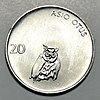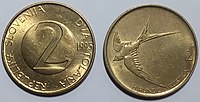| slovenski tolar (Slovene) | |
|---|---|
| ISO 4217 | |
| Code | SIT |
| Unit | |
| Plural | The language(s) of this currency belong(s) to the Slavic languages. There is more than one way to construct plural forms. |
| Symbol | T |
| Denominations | |
| Subunit | |
| 1⁄100 | stotin |
| Banknotes | 10, 20, 50, 100, 200, 500, 1000, 5000, 10,000 tolarjev |
| Coins | |
| Freq. used | 50 stotinov, 1, 2, 5, 10, 20, 50 tolarjev |
| Rarely used | 10, 20 stotinov |
| Demographics | |
| Date of introduction | 8 October 1991 |
| User(s) | None, previously: |
| Issuance | |
| Central bank | Bank of Slovenia |
| Website | www |
| Valuation | |
| Inflation | 0.8% |
| Source | Bank of Slovenia, 2005 |
| Method | Core CPI |
| EU Exchange Rate Mechanism (ERM) | |
| Since | 28 June 2004 |
| Fixed rate since | 11 July 2006 |
| Replaced by euro, non cash | 1 January 2007 |
| Replaced by euro, cash | 14 January 2007 |
| 1 € = | 239.640 tolars |
| Band | 15% |
| This infobox shows the latest status before this currency was rendered obsolete. | |
The tolar was the currency of Slovenia from 8 October 1991 until the introduction of the euro on 1 January 2007. It was subdivided into 100 stotinov (cents). The ISO 4217 currency code for the Slovenian tolar was SIT. From October 1991 until June 1992, the acronym SLT was in use.
History
The name tolar comes from Thaler, and is cognate with dollar. The tolar was introduced on 8 October 1991. It replaced the 1990 (Convertible) version of Yugoslav dinar at parity. On 28 June 2004, the tolar was pegged against the euro in the ERM II, the European Union exchange rate mechanism. All recalled banknotes can be exchanged at the central bank for current issue.
Phase-out
On 1 January 2007, the tolar was supplanted by the euro. Slovenia issues its own euro coins, like all other nations in the Eurozone.
The timescale for conversion from the tolar to the euro operated differently from the first wave of European Monetary Union (EMU). The permanent euro/tolar conversion rate was finalised on 11 July 2006 at 239.640 tolar per euro. Unlike the first wave of EMU, this period was only a day (the conversion rates were fixed on 31 December 1998 and euro non-cash payments were possible from 1 January 1999). Also unlike the first wave of EMU which had a three-year transition period (1999–2001), there was no transition period when non-cash payments could be made in both tolar and euro. The tolar was used for all transactions (cash and non-cash) until 31 December 2006 and the euro was compulsory to use for all payments (cash and non-cash) from 1 January 2007. However, as with the first wave of EMU, cash payments with the tolar could continue until 14 January 2007, but change had to be given in euro.
Coins
In 1992, coins were introduced in denominations of 10, 20 and 50 stotinov (10, 20 and 50 stotins), 1 tolar, 2 tolarja and 5 tolarjev (2 and 5 tolars). 10 tolarjev (10 tolars) coins were added in 2000, followed by 20 and 50 tolarjev (20 and 50 tolars) in 2003. The obverse designs all show the denomination, with animals native to Slovenia on the reverses. The coins were designed by Miljenko Licul and Zvone Kosovelj and featured reliefs of animals by Janez Boljka.
| The Only Series | |||||||||||
|---|---|---|---|---|---|---|---|---|---|---|---|
| Image | Value | Equivalent in euros (€) | Technical parameters | Description | Date of | ||||||
| Diameter | Thickness | Mass | Composition | Edge | Obverse | Reverse | first minting | issue | |||
| 10 stotinov
(10 stotins) |
0.04 cent | 16 mm | 1.3 mm | 0.55 g | 98% aluminium 2% magnesium |
Plain | Value, state title, year of minting | Olm, "PROTEUS ANGUINUS" | 29 April 1993 | ||
 
|
20 stotinov
(20 stotins) |
0.08 cent | 18 mm | 1.3 mm | 0.7 g | Long-eared owl, "ASIO OTUS" | |||||
| 50 stotinov
(50 stotins) |
0.21 cent | 20 mm | 1.3 mm | 0.85 g | Western honey bee, "APIS MELLIFERA" | 4 January 1993 | |||||

|
1 tolar
(1 tolar) |
0.42 cent | 22 mm | 1.7 mm | 4.5 g | 78% copper 20% zinc 2% nickel |
Milled | Value, state title, year of minting | Brown trout, Salmo trutta fario | 4 January 1993 | |

|
2 tolarja
(2 tolars) |
0.83 cent | 24 mm | 1.7 mm | 5.4 g | Barn swallow, "HIRUNDO RUSTICA" | |||||

|
5 tolarjev
(5 tolars) |
2.09 cent | 26 mm | 1.7 mm | 6.4 g | Alpine ibex, "CAPRA IBEX" | |||||

|
10 tolarjev
(10 tolars) |
4.17 cent | 22 mm | 2 mm | 5.75 g | Cupronickel 75% copper 25% nickel |
Milled | Value, state title, year of minting | Horse, "EQUUS" | 19 April 2000 | |

|
20 tolarjev
(20 tolars) |
8.35 cent | 24 mm | 2 mm | 6.85 g | Waved-edge milled | White stork, "CICONIA CICONIA" | 7 July 2003 | |||
| 50 tolarjev
(50 tolars) |
20.86 cent | 26 mm | 2 mm | 8 g | Alternating plain/ milled | Bull, "TAURUS TAURUS" | |||||
| These images are to scale at 2.5 pixels per millimetre. For table standards, see the coin specification table. | |||||||||||
Banknotes
The first banknotes were provisional payment notes issued on 8 October 1991, in denominations of 1, 2, 5, 10, 50, 100, 200, 500, 1000, and 5000 tolarjev (0.50 and 2000 tolarjev notes were also printed, but never issued; one thousand sets with matching serial numbers were sold for 5,000 tolarjev each beginning on 6 May 2002). These notes all feature Triglav, the tallest mountain in Slovenia, on the front, and the Prince's Stone, honeycomb pattern, and Carniolan honey bee on the back.
In 1992, the Bank of Slovenia introduced the following banknotes, all of which feature notable Slovenes. The banknotes were designed by Miljenko Licul and coauthors, with portraits drawn by Rudi Španzel. They were printed by the British company De La Rue on paper produced in Radeče, Slovenia.
| 1992 Series | |||||||||
|---|---|---|---|---|---|---|---|---|---|
| Image | Value | Euro equivalent |
Dimensions | Main colour | Description | Date of | |||
| Obverse | Reverse | first printing | issue | ||||||
| 10 tolarjev | €0.04 | 120 × 60 mm | Green | Primož Trubar | Ursuline Church in Ljubljana Motif from the New Testament |
15 January 1992 | 27 November 1992 | ||
| 20 tolarjev | €0.08 | 126 × 63 mm | Orange | Johann Weikhard von Valvasor | Angels from The Glory of the Duchy of Carniola by Valvasor Segments of the map of Slovenia |
28 December 1992 | |||
| 50 tolarjev | €0.21 | 132 × 66 mm | Violet | Jurij Vega | Solar System Slovenian Academy of Sciences and Arts |
19 March 1993 | |||
| 100 tolarjev | €0.42 | 138 × 69 mm | Yellow | Rihard Jakopič | The Sun by Jakopič Plan of the former Jakopič Pavilion |
30 September 1992 | |||
| 200 tolarjev | €0.83 | 144 × 72 mm | Brown | Jacobus Gallus | Slovenian Philharmonic Hall Musical notations |
22 February 1993 | |||
| 500 tolarjev | €2.09 | 150 × 75 mm | Red | Jože Plečnik | National and University Library of Slovenia | 30 September 1992 | |||
| 1000 tolarjev | €4.17 | 156 × 78 mm | Blue green | France Prešeren | Text from Zdravljica by Prešeren | 30 September 1992 | |||
| 5000 tolarjev | €20.86 | Brown | Ivana Kobilca | National Gallery of Slovenia Robba fountain |
1 June 1993 | 13 December 1993 | |||
| 10 000 tolarjev | €41.73 | Purple | Ivan Cankar | Chrysanthemum Cankar's handwriting |
28 June 1994 | 15 March 1995 | |||
| For table standards, see the banknote specification table. | |||||||||
Historical exchange rates

Lower number indicates the tolar has a higher value.
- SIT per EUR – 233.0 (April 2006); 239.5 (June 2005); 235.7 (November 2003); 227.3 (June 2002). From 1 January 2007 the rate was irrevocably set at 239.640 and has been finalised by the European Commission.
- SIT per USD – 193.0 (April 2006); 198.0 (June 2005); 201.3 (November 2003); 195.06 (January 2000); 181.77 (1999); 166.13 (1998); 159.69 (1997); 135.36 (1996); 118.52 (1995).
See also
References
- "Pregled pomembnejših dogodkov v Sloveniji med 29. junijem in 4. julijem" [Review of More Important Events in Slovenia From 29 June until 4 July] (in Slovenian). Slovenian Press Agency.
- ^ Šiška, Marko (January 2012). "Twenty Years of National Currency". Www.ukom.gov.si. Government Communication Office, Republic of Slovenia. Archived from the original on 2013-10-22.
- Linzmayer, Owen (2012). "Slovenia". The Banknote Book. San Francisco, CA: www.BanknoteNews.com.
- Krause, Chester L.; Clifford Mishler (1991). Standard Catalog of World Coins: 1801–1991 (18th ed.). Krause Publications. ISBN 0873411501.
- Pick, Albert (1994). Bruce, Colin R. II; Shafer, Neil (eds.). Standard Catalog of World Paper Money: General Issues (7th ed.). Krause Publications. ISBN 0-87341-207-9.
External links
- Information on the Slovenian tolar, Bank of Slovenia
- Heiko Otto (ed.). "Historical banknotes of Slovenia" (in English and German). Retrieved 2018-08-13.
| Euro topics | |||||||||
|---|---|---|---|---|---|---|---|---|---|
| General | |||||||||
| Administration | |||||||||
| Fiscal provisions | |||||||||
| Economy | |||||||||
| International status | |||||||||
| Denominations |
| ||||||||
| Coins by country with minting rights |
| ||||||||
| Non-EU territories using euro per agreement without minting rights | |||||||||
| Potential adoption by other countries | |||||||||
| Countries and territories using euro unilaterally | |||||||||
| Other extant EU currencies |
| ||||||||
| History |
| ||||||||
| Currencies named dollar or similar | |
|---|---|
| Circulating |
|
| Circulating, but renamed | |
| Defunct |
|
| Noncirculating | |
| Conceptual |
|
| Virtual | |
| Fictional | |
| Private | |
| See also | |
| Thaler | ||
|---|---|---|
| 19th century |
|  |
| 18th century |
| |
| 17th century |
| |
| 15th and 16th centuries |
| |
| See also | ||